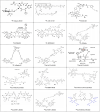Preliminary Clinical Application of RGD-Containing Peptides as PET Radiotracers for Imaging Tumors
- PMID: 35311120
- PMCID: PMC8924613
- DOI: 10.3389/fonc.2022.837952
Preliminary Clinical Application of RGD-Containing Peptides as PET Radiotracers for Imaging Tumors
Abstract
Angiogenesis is a common feature of many physiological processes and pathological conditions. RGD-containing peptides can strongly bind to integrin αvβ3 expressed on endothelial cells in neovessels and several tumor cells with high specificity, making them promising molecular agents for imaging angiogenesis. Although studies of RGD-containing peptides combined with radionuclides, namely, 18F, 64Cu, and 68Ga for positron emission tomography (PET) imaging have shown high spatial resolution and accurate quantification of tracer uptake, only a few of these radiotracers have been successfully translated into clinical use. This review summarizes the RGD-based tracers in terms of accumulation in tumors and adjacent tissues, and comparison with traditional 18F-fluorodeoxyglucose (FDG) imaging. The value of RGD-based tracers for diagnosis, differential diagnosis, tumor subvolume delineation, and therapeutic response prediction is mainly discussed. Very low RGD accumulation, in contrast to high FDG metabolism, was found in normal brain tissue, indicating that RGD-based imaging provides an excellent tumor-to-background ratio for improved brain tumor imaging. However, the intensity of the RGD-based tracers is much higher than FDG in normal liver tissue, which could lead to underestimation of primary or metastatic lesions in liver. In multiple studies, RGD-based imaging successfully realized the diagnosis and differential diagnosis of solid tumors and also the prediction of chemoradiotherapy response, providing complementary rather than similar information relative to FDG imaging. Of most interest, baseline RGD uptake values can not only be used to predict the tumor efficacy of antiangiogenic therapy, but also to monitor the occurrence of adverse events in normal organs. This unique dual predictive value in antiangiogenic therapy may be better than that of FDG-based imaging.
Keywords: FDG; PET/CT imaging; RGD; diagnosis; differential diagnosis; therapeutic response prediction; tumor subvolume delineation.
Copyright © 2022 Li, Chen, Yu and Yuan.
Conflict of interest statement
The authors declare that the research was conducted in the absence of any commercial or financial relationships that could be construed as a potential conflict of interest.
Figures

Similar articles
-
More advantages in detecting bone and soft tissue metastases from prostate cancer using 18F-PSMA PET/CT.Hell J Nucl Med. 2019 Jan-Apr;22(1):6-9. doi: 10.1967/s002449910952. Epub 2019 Mar 7. Hell J Nucl Med. 2019. PMID: 30843003
-
Evaluation of a CD13 and Integrin αvβ3 Dual-Receptor Targeted Tracer 68Ga-NGR-RGD for Ovarian Tumor Imaging: Comparison With 18F-FDG.Front Oncol. 2022 May 18;12:884554. doi: 10.3389/fonc.2022.884554. eCollection 2022. Front Oncol. 2022. PMID: 35664759 Free PMC article.
-
Clinical Evaluation of 68Ga-FAPI-RGD for Imaging of Fibroblast Activation Protein and Integrin αvβ3 in Various Cancer Types.J Nucl Med. 2023 Aug;64(8):1210-1217. doi: 10.2967/jnumed.122.265383. Epub 2023 May 4. J Nucl Med. 2023. PMID: 37142301 Free PMC article.
-
Radiolabeled cyclic RGD peptides as radiotracers for tumor imaging.Biophys Rep. 2016;2(1):1-20. doi: 10.1007/s41048-016-0021-8. Epub 2016 Apr 12. Biophys Rep. 2016. PMID: 27819026 Free PMC article. Review.
-
Radiolabeled Cyclic RGD Peptide Bioconjugates as Radiotracers Targeting Multiple Integrins.Bioconjug Chem. 2015 Aug 19;26(8):1413-38. doi: 10.1021/acs.bioconjchem.5b00327. Epub 2015 Aug 3. Bioconjug Chem. 2015. PMID: 26193072 Free PMC article. Review.
Cited by
-
A comparison of [18F]AlF- and 68Ga-labeled dual targeting heterodimer FAPI-RGD in malignant tumor: preclinical evaluation and pilot clinical PET/CT imaging.Eur J Nucl Med Mol Imaging. 2024 May;51(6):1685-1697. doi: 10.1007/s00259-023-06587-5. Epub 2024 Jan 22. Eur J Nucl Med Mol Imaging. 2024. PMID: 38246909
-
Engineered Polymeric Nanovector for Intracellular Peptide Delivery in Antitumor Therapy.Int J Nanomedicine. 2023 Sep 19;18:5343-5363. doi: 10.2147/IJN.S427536. eCollection 2023. Int J Nanomedicine. 2023. PMID: 37746048 Free PMC article.
-
Systematic Review: Targeted Molecular Imaging of Angiogenesis and Its Mediators in Rheumatoid Arthritis.Int J Mol Sci. 2022 Jun 25;23(13):7071. doi: 10.3390/ijms23137071. Int J Mol Sci. 2022. PMID: 35806074 Free PMC article.
-
Peptide-Based Agents for Cancer Treatment: Current Applications and Future Directions.Int J Mol Sci. 2023 Aug 18;24(16):12931. doi: 10.3390/ijms241612931. Int J Mol Sci. 2023. PMID: 37629112 Free PMC article. Review.
-
Identification of an IGF2BP2-Targeted Peptide for Near-Infrared Imaging of Esophageal Squamous Cell Carcinoma.Molecules. 2022 Nov 6;27(21):7609. doi: 10.3390/molecules27217609. Molecules. 2022. PMID: 36364436 Free PMC article.
References
Publication types
LinkOut - more resources
Full Text Sources

